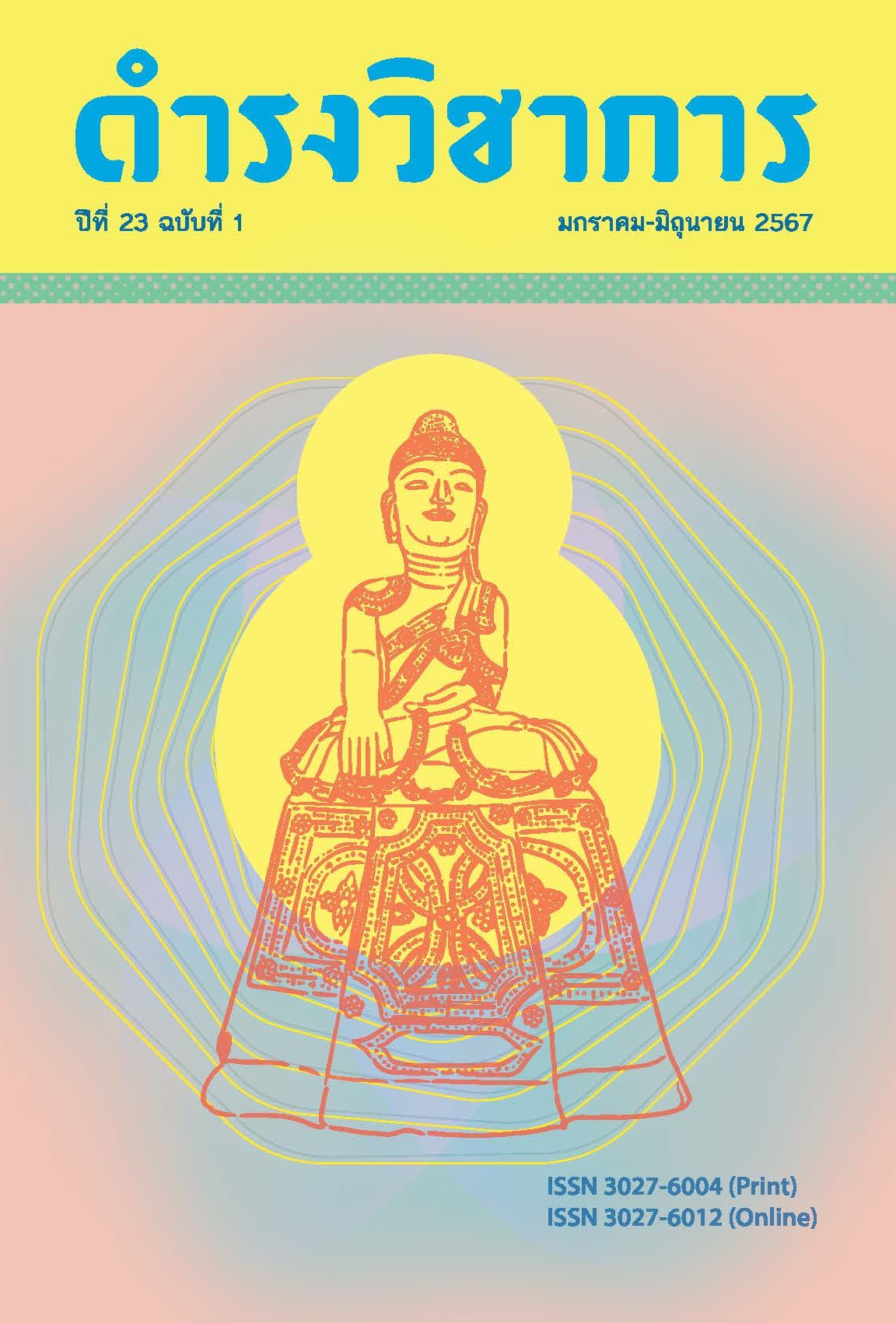Buddha Image Made of Flowers in Phrao District Chiang Mai Province: Patterns and Inscriptions
Keywords:
Buddha statue made of flowers, patterns, inscriptionsAbstract
This research article aims to analyze the patterns and inscriptions at the base of the Buddha image in Phrao District, Chiang Mai Province. The results of the study showed that Flower Buddha images can be divided into standing and sitting Buddha images. The standing Buddha image depicts a round object in his hand. This may refer to the Buddha taking the anchor fruit in Theravada or Bhaisajyaguru in Mahayana. The sitting Buddha images dressed in royal clothes are found in two styles: wearing a high and low crown and wearing long and short sleeve clothes. For sitting Buddha images not dressed in royal attire, a unique feature is seen in pulling the robe to cover the right shoulder in a semicircle shape and overlapping the robes on the left shoulder. In addition, the disciple sculptures, Phra Upakut and Phra Bua Khem, were found with inscriptions at the base, which could be inscribed with three types of characters: Lanna script, Tai script and Burmese script. The oldest inscription is 1895; the most common is 1927; and the newest is 1935, and all of the inscriptions were in the reign of Kruba Bhun Chao Boon Chum Sirivichayo, the abbot of Wat Pa Tum Don, which was the period before and after the construction of the temple. All Buddha images had been imported from Burma by merchants in the 25th century of the Buddhist Era. The inscription contains contents about the age of Buddhism and wishes of having nirvana as the ultimate goal.
References
กรมการศาสนา, 2533. ประวัติวัดทั่วราชอาณาจักร เล่ม 9. กรุงเทพฯ: โรงพิมพ์การศาสนา.
¬กรมศิลปากร, 2558. พระพุทธรูปปางต่างๆ. กรุงเทพฯ: รุ่งศิลป์การพิมพ์.
ครูบาประเสริฐ ปวโร, 2566. เจ้าอาวาสวัดหนองปลามัน. สัมภาษณ์, 12 มีนาคม.
จุลจอมเกล้าเจ้าอยู่หัว, พระบาทสมเด็จพระ, 2526. พระราชพิธีสิบสองเดือน. กรุงเทพฯ: ศิลปาบรรณาคาร.
ณัฐวุฒิ สุทธิสงคราม, 2502. พระบัวเข็ม. กรุงเทพฯ: มหามกุฏราชวิทยาลัย, 2502.
ธนุตม์ ธรรมพิทักษ์, 2563. รายงานวิจัยเรื่อง “แนวคิด ความเชื่อ และพุทธปฏิมากรรมเฉพาะ
ของพระไภษัชยคุรุฯ โดยใช้ประติมานวิทยา”. กรุงเทพฯ: ภาควิชาทัศนศิลป์ คณะศิลปกรรมศาสตร์
มหาวิทยาลัยกรุงเทพ.
ปรมานุชิตชิโนรส, สมเด็จพระมหาสมณเจ้า กรมพระ, 2530. ปฐมสมโพธิกถา. กรุงเทพฯ: กองวรรณคดีและ
ประวัติศาสตร์ กรมศิลปากร.
พระปัญญานุนทมุนี, 2509. พระบัวเข็ม. กรุงเทพฯ: มหามกุฏราชวิทยาลัย.
พระศรีวิสุทธิวงศ์, 2598. พระพุทธศาสนาห้าพันปี. กรุงเทพฯ: มหามกุฏราชวิทยาลัย.
มูลนิธิสารานุกรมวัฒนธรรมไทย ธนาคารไทยพาณิชย์, 2552. สารานุกรมวัฒนธรรมไทยภาคเหนือ เล่ม 8.
กรุงเทพฯ: ไทยพาณิชย์.
วัชราภรณ์ ดิษฐป้าน, 2556. “ตำนานอุปคุตในสังคมไทย: การรับรู้ตำนานพระอุปคุตและความสับสนกับ
ประวัติของพระสาวกรูปอื่น.” วรรณวิทัศน์ (พฤศจิกายน 2556): 1-28.
ฮันส์ เพนธ์, 2519. คำจารึกที่ฐานพระพุทธรูปในนครเชียงใหม่. กรุงเทพฯ: สำนักนายกรัฐมนตรี.
Downloads
Published
Issue
Section
License
Copyright (c) 2024 Damrong Journal of The Faculty of Archaeology Silpakorn University

This work is licensed under a Creative Commons Attribution-NonCommercial-NoDerivatives 4.0 International License.
บทความนี้เป็นผลงานของข้าพเจ้าแต่เพียงผู้เดียว และ/หรือเป็นผลงานของข้าพเจ้าและผู้ร่วมงาน ตามชื่อที่ระบุในบทความจริง และเป็นผลงานที่มิได้ถูกนำเสนอหรือตีพิมพ์ที่ใดมาก่อน





